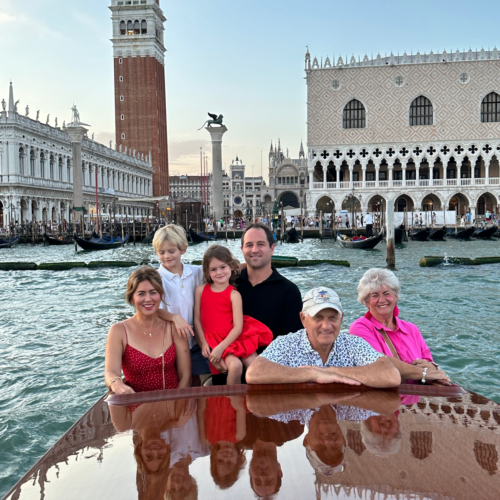One of the things that I have done in the last year that has really advanced my personal growth is not only following people that think differently than me and might disagree with me, but listening to what they have to say and having those difficult conversations. In doing so, I am so proud to say that I have created a community of people that I otherwise might not have connected with, and they have really made me think of things differently.
This past year, one of those people I met online is Nicole; I will get into more details on how we met in another post. Nicole has many lived experiences as it relates to homelessness, drug use, and navigating the mental health system. Through some rather tough conversations, I have learned so much from her over the last year.
There have been many polarizing conversations happening recently. I have been continuing to shed light on some of those topics on the blog in a respectful and eye-opening manner. While Nicole is an adult, I want to protect her as it can be scary to put your views out there. If you disagree, you are entitled to your own opinion, but please be respectful and don’t reach out to Nicole to share those opinions.
How You Supported Housing Solutions in the upper East Side
I am so pleased to announce this month’s recipient of our Cameo donation was Watari Counselling & Support Services. As a community, we were able to raise $6004, which will go to a grassroots organization that compassionately addresses housing insecurity and the mental wellbeing of vulnerable people downtown Vancouver, BC.
Watari Counselling & Support Services Society’s mission is to “facilitate meaningful change and provide a bridge to healthier possibilities through innovative, community driven and supportive programming.”
Thank you to all those who showed up for mine and Nicole’s IG live, if you were unable to attend I encourage you to go check it out. I love how Nicole explores the intersection of class and poverty and prompts us to really explore how we as a society define mental illness.
One thing’s for sure, we need to pull together and find creative solutions for how we help those suffering from the traumatizing effects of poverty and mental illness. I look forward to continuing to educate myself and bring awareness to these issues and hope that this contribution inspires more individuals to donate to grassroot charities such as Watari Counselling.
If you feel compelled to support this charity please check out Watari Counselling & Support Services Society.
Without further adieu, I am so honored to welcome Nicole to the blog! Take it away!
The opinions expressed in this piece are my own. I have developed them through lived experience of homelessness, addiction, eating disorders, and engagement, both voluntary and not, with the psychiatric system. In the last decade, I have also researched these phenomena systematically while obtaining undergraduate and graduate degrees in medical sociology; I have taught college-level courses about these topics; I have published articles about them in academic journals and in a forthcoming book; and, most importantly, I am engaged in ongoing activism and advocacy related to housing justice and drug policy reform in Vancouver, British Columbia. My heart and allegiances are with the many people who may share my perspectives but who won’t be given a public platform to discuss them.
I’d like to begin this piece with a thought experiment. Read the following vignette. As you do so, notice the thoughts, feelings, and bodily responses that you experience:
You are poor. You are so poor, in fact, that you live out of a homeless shelter. At night, you sleep on a single mattress that has been placed onto a cement floor under harsh, fluorescent lights. Yours is just one of several dozen mattresses, and you never know in advance who your neighbor will be, if they will harm you, or whether your belongings will still be there in the morning.
A staff member rouses you awake at 7am. You eat a breakfast of dry toast and cereal before having to leave. The shelter doesn’t open again until after dinner. You spend the morning at a drop-in centre, where you wait in line to use a computer. You know that it is almost impossible to find employment without a fixed address, but if you don’t submit a “Work Search Activities Record” document to the government each month, you will stop receiving your $7101 income assistance (“welfare”) cheque. This is your only money. At lunch, you’re hungry. However, eating would mean waiting in line again, this time at a different drop-in centre. It’s wet. You’re cold. And, when you eventually sit in a doorstep to take cover from the rain, a business owner emerges from his store front, yelling expletives and threatening to call the police if you don’t move immediately.
What I’ve just described might seem unimaginable to most. But for me, a “seriously mentally ill” person as defined by the mental health industry, who also lives with the trauma of having been homeless in my teens and early twenties, this scenario is one in which I am all too familiar. Years later, in the present day, I am a researcher, writer, and occasional consumer of psychiatric services, and I have learned that much of what we are told by mental health campaigns and other media about “serious mental illness” is wrong. Specifically, mental illness is not a result of bad genetics or “chemical imbalances” in the brain, and risk of mental illness does not affect all populations equally. In fact, the biggest predictor of being diagnosed with a serious mental illness is socioeconomic status, or class position. To put it bluntly, poverty – the deep, inescapable kind that I’ve just described – makes people “crazy”. I will spend the remainder of this post explaining what a common misconception about mental health is, why you should care, and how this new perspective can help inform your efforts to support mental health advocacy.

Image Credit: Haute Stock
Who defines “mental illness”? Some concerns with diagnoses
First, what is considered “serious mental illness?” This is not a simple question, because unlike physical illness, mental illness has no measurable bodily characteristics: It doesn’t appear on brain scans, there is no blood test for it, and studies that compare the genetics of mentally ill and “sane” people have been inconclusive, at best.2 This means that all “seriously mentally ill” people have been labeled based on behaviour and behaviour alone. And, since psychiatrists and other mental health professionals are human, they can have the same conscious and unconscious biases about appearance that everybody else does. This often means that groups with minimal power and privilege, particularly those who are visibly poor, are more likely to be seen by mental health professionals as “sick,” “crazy,” and “bad” in relation to those who aren’t.
To better understand why diagnosing mental health conditions is more of an art than a science, I’ll offer a bit of historical context: Psychiatry emerged as a profession in Europe roughly two hundred years ago, during a period of rapid social and economic change. During this time, unemployed people, or “the idle,” were deemed insane and confined to labour institutions alongside “beggars” and “thieves.”3 This was because in religious societies, contributing to the economy was considered a moral duty. Those who didn’t work were seen as rejecting God’s will – something only the “feeble-minded” did. And today, while it is no longer acceptable to diagnose or involuntarily commit someone to a psychiatric ward for religious reasons, the same rigid standards of “normalcy” established by the earliest psychiatrists, all of them White, wealthy, European men, are baked into the fabric of the mental health system.
In practice, this means that psychiatry has historically been used and can still be used to regulate and control people who are perceived as most undesirable by the dominant class. Concrete examples of this include “drapetomania,” a diagnosis given to enslaved peoples who tried to escape captivity,4 “protest psychosis,” a label that justified involuntarily committing Black Civil Rights activists during the 1960s,5 the fact that homosexuality was considered a mental illness until the 1970s,6 and the ongoing labeling of Indigenous cultural beliefs as “hallucinations” and “delusions” by western mental health practitioners.7 When it comes to wealth disparities, these differences are especially pronounced: Most mental health professionals haven’t experienced the extreme stress of unemployment, homelessness, discrimination, and constant neighbourhood violence. Even though we now know that stress “gets under the skin” to literally change brain functioning, and that being in “fight, flight, or freeze” mode for long periods of time can mirror the symptoms of psychosis,8 mental health providers rarely screen for environmental factors when diagnosing and treating patients. This means that poor people are sometimes labeled with stigmatized, demoralizing mental illnesses when what they really need is compassion, safety, and money.

Image Credit: Haute Stock
The role that poverty plays in navigating the mental health system
It is not a coincidence that children raised in poverty are roughly 3x more likely than their wealthier peers to be diagnosed with a “serious mental illness” later in life.9 This isn’t because poor people are genetically predisposed to insanity, it is because the trauma of poverty can result in smaller brain size and manifest as erraticism, drug addiction, and mood swings.10 However, our current approach to wellness is based on the assumption that solutions are to be found by focusing on individual brain chemistry, as well as personal self-care practices. We take for granted that people have the resources to do the latter, and we also fail to acknowledge that a person’s wealth will hugely impact how they are treated when accessing support. Put differently, while all people can seriously struggle with their mental health, poor people, and particularly the homeless, are more likely to be invalidated, mis-diagnosed, and outright harmed by the mental health system.
When I say this, some people are surprised or get defensive. Those who don’t know much about deep, entrenched, poverty struggle to imagine why anyone would be scared of medical professionals, particularly ones whose job it is to focus on our minds. However, those who have been traumatized and historically harmed by psychiatry, and who are in regular contact with non-profit organizations such as homeless shelters and drop-in centres, have good reason to be afraid. This is because most of these organizations are at least partially funded by the government, and in exchange for this funding, their priorities are focused on cost-efficiency, reducing social disorder, and minimizing crime.11 Over time, they have tried to do this by involving more and more “mental health initiatives” into their mandates, and now, many non-profits operate almost identically to psychiatric wards. For instance, staff members are often required to documents clients’ movements in, out, and through facilities, they may have to report any perceived symptoms to on-site medical professionals, and in some cases, hybrid police-mental health teams are authorized to check if clients have taken their medication, and to arrest and commit them if they haven’t.12 Remember the 17th and 18th century prisons for the “idle” I mentioned earlier? As it turns out, some present-day non-profits have not evolved at all.

Image Credit: Haute Stock
What is justice-oriented care? Leaving “recovery narratives” behind
So how do we improve mental health for all? Again, there is no easy, one-size-fits-all answer to this. We can begin by redefining our standards of what is considered normal. Ask yourself, “Where do our definitions of ‘normal’ come from? Who in society has the power to tell us what is ‘normal,’ and why is it important to us and others that we are seen this way? I suggest this exercise because if we think carefully, ‘normalcy,’ including working hard, making and spending money, being ‘nice,’ taking care of our bodies, respecting authority, and being a responsible citizen, starts to seem like it might be less about freedom and more about privilege and maintaining the status quo. Who benefits from “normalcy”? It isn’t a coincidence that most of history’s biggest change-makers were deemed “crazy” by those who already had wealth, status, and influence.
If we suspend our beliefs about what other people’s mental health should look like, this can inform the causes we support. Everyone who wants it should have access to mental health treatment. However, this treatment should be based on informed consent, not coercion. This means that it shouldn’t be leveraged in exchange for housing, food, or dignity. And keep in mind that when it comes to those living in conditions of extreme material deprivation, mental illness is often not the issue – poverty is. Therefore, if you’d like to donate to a housing non-profit, research it carefully: Do clients have to take medication to stay there? What happens if they want a bed, but to not meet with professionals or follow a “treatment plan?” Will they be allowed to stay? Next, where will your money actually go? Often, the biggest non-profits are run much like corporations are, with executive directors making hundreds of thousands of dollars per year while front-line staff get paid minimum wage with no health benefits.14 A good rule of thumb is that if an organization profits off of poverty – that is, if multiple people are making large salaries simply because poverty exists – their programming won’t meaningfully address social inequalities or meet their client’s needs. Look for groups that are run by and for the communities they serve, who re-distribute wealth evenly amongst their workers and their clients. These tend to “meet people where they’re at” in ways that are less judgemental, less hierarchical, and more focused on solutions.
Finally, an undeniable fact of mental health and illness is that these are collective struggles. Socioeconomic disparities are the leading determinant of how one feels, and societies that are characterized by huge wealth gaps are antithetical to wellness. Therefore, donating money, irrespective of amount and even with the best intentions, is akin to putting a band-aid on a gaping wound. What we really need is a surgery in the form of social security and strong welfare supports. To achieve this, those who are most comfortable in life should anticipate giving something up beyond the occasional donation. Advocacy that leads to policy change is a long-game, and the best thing we can do to move toward a gentler, more mentally healthy society is to recognize where we contribute to others’ lack of safety. Moving through the world this way isn’t instantly gratifying, but doing so will prevent material deprivation and its attendant mental distress for future generations.
Nicole Luongo
Follow Nicole on IG @luongonm
Preorder Nicole’s Book – The Becoming
Further reading:
- Note that the provincial government in B.C. just announced a $125 permanent increase to income assistance and disability rates. The month income assistance rate will now be $935, but this comes after a decade of the rate being frozen. See attached for the “work search activities record” that recipients must submit each month to continue receiving their allotment: https://www2.gov.bc.ca/assets/gov/british-columbians-our-governments/policies-for-government/bc-employment-assistance-policy-procedure-manual/forms/pdfs/hr0077.pdf
- See https://www.madinamerica.com/2020/07/genetic-testing-may-explain-less-1-mental-health-issues/
- Historian and philosopher Michel Foucault wrote extensively about “the great confinement,” a period during the mid-17th and early 18th century where management of the unemployed, or the “idle,” criminals, and the insane, was considered the same task. During this time, those who didn’t contribute to Industrial-Revolution-era economic and socio-political shifts were placed together in institutions that had once been used for leprosy patients and forced to engage in the labour that they weren’t doing while “free.” These are considered by some to be the earliest insane asylums. See https://telanganatoday.com/the-new-great-confinement
- In 1851, Louisiana surgeon and psychologist Dr. Samuel Cartwright filed a report with the New Orleans Medical and Surgical Journal coining the term “drapetomania” – the mental disease that caused enslaved people to flee captivity. He stated that the disease was linked to Black people’s inferior mental status, but that it was treatable through discipline and Christianity. See https://www.nytimes.com/2000/01/15/arts/bigotry-as-mental-illness-or-just-another-norm.html
- Anti-Black racism hasn’t been eliminated from the psychiatric profession, but it has transformed. “Protest psychosis,” a diagnosis given to Black Civil Rights-era activists, was described as “a reactive psychosis,” which White psychiatrists believed was triggered when external stressors caused an ego rupture with reality. It was mostly diagnosed among Black men who were subsequently incarcerated and prohibited from attending protests, etc. This set the stage for schizophrenia being referred to today as “the Black disease” due to its overdiagnoses in Black populations. See https://www.psychologytoday.com/ca/blog/side-effects/201005/how-schizophrenia-became-black-disease-interview-jonathan-metzl
- See https://www.thelancet.com/journals/lanpsy/article/PIIS2215-03661930059-8/fulltext
- In the west, some mental illness labels are what we refer to as “culture-bound syndromes”; they exist as a collection of “signs” and “symptoms” based on the shared knowledge and beliefs of those who have created the mental health system, but their meaning in restricted or non-existent in other contexts. For Indigenous peoples, colonialism dictates how mental health is understood, measured, and treated. However, the trauma of being colonized and the legacy of colonization are rarely considered by western practitioners who diagnose and treat Indigenous peoples. See http://www.ccnsa.ca/Publications/Lists/Publications/Attachments/70/colonial_norms_EN_web.pdf
- “Epigenetics” refers to how environmental changes can alter the structure of physical DNA and how one’s body reads and expresses gene sequences. Researchers have learned that the expression of our genetic make-up is influenced by environmental stressors such as violence, prejudice, and discrimination, as well as toxins and diet, and that all can “turn off” genes that help with things like self-regulation, mental stability, and impulse control, including for future generations. This is what we mean by “stress gets under the skin” – our environment literally changes our bodies and minds. See https://www.madinamerica.com/2018/06/epigenetics-evolution-revolution/
- See https://bcmj.org/sites/default/files/public/BCMJ_Vol58_No8_Children-mental-health-poverty%20%28ID%20106172%29.pdf
- See https://www.madinamerica.com/2013/10/poverty-results-smaller-brain-size/
- See https://incite-national.org/beyond-the-non-profit-industrial-complex/
- The “Assertive Community Treatment,” or ACT team defines itself as a “recovery-oriented mental health service delivery model” that serves clients “living with complex mental illness and substance abuse disorders” who “are overrepresented among the homeless, jails, and correctional facilities.” Although the British Columbia government claims that ACT team involvement enhances client functioning, many people who are enrolled in the program have reported feeling coerced into taking medication and as though they have little-no privacy. Note that “recovery-oriented” in this context refers to expecting clients to comply with social norms around “appropriate behaviour,” but that most clients are unstably housed, sometimes without social support, and tend to live in extremely stressful environments.




